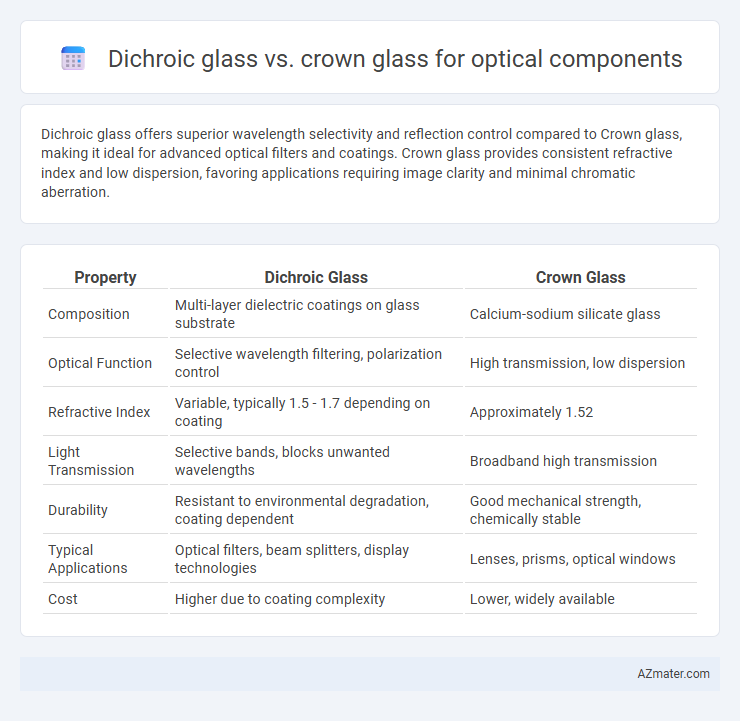Dichroic glass offers superior wavelength selectivity and reflection control compared to Crown glass, making it ideal for advanced optical filters and coatings. Crown glass provides consistent refractive index and low dispersion, favoring applications requiring image clarity and minimal chromatic aberration.
Table of Comparison
| Property | Dichroic Glass | Crown Glass |
|---|---|---|
| Composition | Multi-layer dielectric coatings on glass substrate | Calcium-sodium silicate glass |
| Optical Function | Selective wavelength filtering, polarization control | High transmission, low dispersion |
| Refractive Index | Variable, typically 1.5 - 1.7 depending on coating | Approximately 1.52 |
| Light Transmission | Selective bands, blocks unwanted wavelengths | Broadband high transmission |
| Durability | Resistant to environmental degradation, coating dependent | Good mechanical strength, chemically stable |
| Typical Applications | Optical filters, beam splitters, display technologies | Lenses, prisms, optical windows |
| Cost | Higher due to coating complexity | Lower, widely available |
Introduction to Optical Glass Materials
Dichroic glass and crown glass serve distinct roles in optical components due to their unique material properties. Dichroic glass is engineered with multiple thin-film optical coatings, enabling selective wavelength reflection and transmission, making it ideal for color filtering and beam splitting applications. Crown glass, characterized by its relatively low refractive index (around 1.52) and low dispersion, offers excellent clarity and minimal chromatic aberration, commonly used in lenses and prisms for general optical systems.
Overview of Dichroic Glass
Dichroic glass is a specialized optical material characterized by its multi-layer dielectric coatings that selectively reflect and transmit specific wavelengths of light, enabling precise color filtering and beam splitting in optical components. It offers superior spectral performance and high durability, making it ideal for applications such as fluorescence microscopy, laser systems, and color separation devices, where accurate wavelength control is essential. Compared to crown glass, which is primarily valued for its optical clarity and low dispersion, dichroic glass provides enhanced wavelength specificity and reflection properties critical for advanced light management.
Overview of Crown Glass
Crown glass, a common optical material characterized by low dispersion and high transparency, is widely used in lenses, prisms, and optical windows due to its stable refractive index around 1.52. Compared to dichroic glass, which selectively reflects and transmits specific wavelengths, crown glass offers superior uniformity and minimal chromatic aberration, making it ideal for precision optical components. Its chemical durability and ease of fabrication further enhance its suitability for applications requiring consistent light transmission and minimal distortion.
Light Transmission Properties Comparison
Dichroic glass exhibits superior control over light transmission by selectively reflecting specific wavelengths while allowing others to pass, providing high spectral purity and minimal light loss. Crown glass offers broad wavelength transmission with low dispersion and moderate transmittance, ideal for general optical applications but lacking the precise spectral filtering of dichroic glass. For optical components requiring targeted wavelength separation and high efficiency, dichroic glass outperforms crown glass in both spectral selectivity and transmission performance.
Optical Performance and Efficiency
Dichroic glass offers superior optical performance in filtering specific wavelengths with high precision, making it ideal for applications requiring selective light transmission and reflection. Crown glass provides excellent clarity and low dispersion, resulting in minimal chromatic aberration and reliable light transmission efficiency in standard optical components. While dichroic glass excels in wavelength-selective efficiency, crown glass remains preferred for general-purpose optics due to its balanced refractive index and uniform transmission characteristics.
Color Filtering and Wavelength Selectivity
Dichroic glass exhibits superior color filtering and wavelength selectivity compared to crown glass due to its multilayer interference coatings that precisely reflect or transmit specific wavelengths. Crown glass, primarily composed of silica and alkali metal oxides, offers broader transmission without selective filtering, making it less effective for applications demanding strict wavelength separation. The advanced interference-based filtering in dichroic glass enables accurate spectral division crucial for high-performance optical components in imaging and laser systems.
Durability and Environmental Resistance
Dichroic glass exhibits superior durability compared to crown glass due to its multilayer coating that enhances resistance to scratches, thermal stress, and chemical corrosion, making it ideal for demanding optical applications. Crown glass, while having good optical clarity and stability, is more susceptible to environmental factors such as moisture and temperature fluctuations, potentially leading to degradation over time. The robust environmental resistance of dichroic glass ensures longer lifespan and consistent performance in harsh conditions, outperforming crown glass in durability metrics for optical components.
Cost and Availability Considerations
Dichroic glass typically incurs higher costs due to complex manufacturing processes involving multiple thin-film coatings, whereas crown glass remains more affordable and widely available because of its simpler production and abundant raw materials. Availability of dichroic glass can be limited, often requiring specialized suppliers, while crown glass benefits from mass production and global distribution. Cost-efficiency and accessibility make crown glass preferable for high-volume optical components, but dichroic glass is chosen for applications demanding precise wavelength filtering despite its price and supply constraints.
Typical Applications in Optical Components
Dichroic glass is predominantly used in optical components requiring precise wavelength filtering, such as beam splitters and color separation filters in cameras and projectors. Crown glass is favored for lenses and prisms in optical instruments due to its low dispersion and high transparency, making it suitable for eyeglasses, microscopes, and telescopes. The distinct refractive indices and spectral properties of dichroic and crown glass define their specialized roles in optical component manufacturing.
Choosing the Right Glass for Your Optical Needs
Dichroic glass offers precise wavelength selectivity and high spectral efficiency, making it ideal for applications requiring color filtering and beam-splitting in optical systems. Crown glass features low dispersion and high optical clarity, providing excellent image quality with minimal chromatic aberration, suitable for lenses and prisms in general optics. Selecting between dichroic and crown glass depends on specific optical requirements such as spectral filtering capabilities versus broadband clarity and low distortion.

Infographic: Dichroic glass vs Crown glass for Optical component
 azmater.com
azmater.com